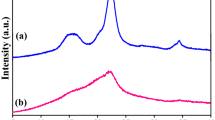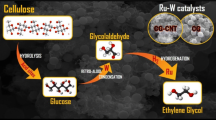Abstract
Conversion of cellulose into glucose is one of the important approaches to biomass utilization, but the insolubility of cellulose in water makes it difficult to hydrolyze particularly in the case of heterogeneous catalysis due to the mass transfer obstacle between solid catalyst particles and cellulose particles. Temperature-responsive HCl-releasing catalysts have unique characteristic as they allow to catalyze the hydrolysis reaction of cellulose under homogeneous catalysts while the released HCl can be recovered and reused via simple cooling after reaction. In this paper, three mesoporous N-doped carbon materials (CNs) with temperature-responsive HCl-releasing ability were synthesized by carbonization of aminoguanidine hydrochloride at 400, 500 and 600 °C respectively. The basicity and the temperature-responsive HCl-releasing behavior of the as-prepared CNs are examined by means of acid–base titration and high temperature releasing experiment. The experimental results show that, of the three samples, CN-400 possesses the maximum HCl intake of 1.28 mmol HCl/g and can release about 1.15 mmol HCl/g when being heated to 220 °C. Employing CN-400·nHCl as the catalyst, a total reducing sugars (TRS) yield of 81.1% and 61.1% glucose yield can be obtained after reaction under 220 °C for 60 min. The considerable basic sites are derived from the pyridine nitrogen and indispensable for HCl-releasing to catalyze cellulose hydrolysis. Furthermore, CN-400·nHCl possesses excellent catalytic stability.
Graphic Abstract
Temperature-responsive acid-releasing catalysts provide a novel and green solid-liquid phase cellulose conversion reaction system.












Similar content being viewed by others
References
Onel O, Niziolek AM, Floudas CA (2015) Curr Opin Chem Eng 9:66–74
Delidovich I, Leonhard K, Palkovits R (2014) Energy Environ Sci 7:2803–2830
Jin F, Enomoto H (2011) Energy Environ Sci 4:382–397
Gallezot P (2012) Chem Soc Rev 41:1538–1558
Rosatella AA, Simeonov SP, Frade RFM, Afonso CAM (2011) Green Chem 13:754–793
Yao L, Liu X, Zhang Y, Jiang K, Wang J, Zhang SJ (2017) ACS Sustainable Chem Eng 5:3417–3428
Moliner M, Roman YL, Davis ME (2010) Natl Acad Sci USA 107:6164–6178
Nguyen H, Nikolakis V, Vlachos DG (2016) ACS Catal 6:1497–1504
Silva MJD, De CM (2018) Oliveira. Curr Catal 7:26–34
Iskak NAM, Julkapli NM, Hamid SBA (2017) Cellulose 24:1–13
Yang L, Yang X, Tian E, Lin H (2016) Chemsuschem 9:36–41
Onda A, Ochi T, Yanagisawa K (2009) Top Catal 52:801–807
Lai DM, Deng L, Li J, Liao B, Guo QX, Fu Y (2011) Chemsuschem 4:55–58
Takagaki A, Tagusagawa C, Domen K (2008) Chem Commun 42:5363–5365
Tian J, Wang J, Zhao S, Jiang C, Zhang X, Wang X (2010) Cellulose 17:587–594
Zhao S, Cheng M, Li J, Tian J, Wang X (2011) Chem Commun 47:2176–2188
Qi X, Yan L, Shen F, Qiu M (2019) Bioresour Technol 273:687–691
Su J, Mo Q, Feng S, Qi X (2018) Cellulose 25:17–22
Saha D, Bramer SEV, Orkoulas G, Ho HC, Chen J, Henley DK (2017) Carbon 121:257–266
Zou K, Deng Y, Chen J, Qian Y, Yang Y, Li Y, Chen G (2018) J Power Sources 378:579–588
Cowan JJ, Bailey AJ, Heintz RA, Bao TD, Hardcastle KI, Hill CL, Weinstock IA (2001) Inorganic Chem 40:6666–6675
Han S, Hou W, Xu J, Li Z (2004) Colloid Polym Sci 282:1286–1291
Ngee ELS, Gao Y, Xi C, Lee TM, Hu Z, Dan Z, Ning Y (2014) Eng Chem Res 53:14225–14233
Talapaneni SN, Mane GP, Mano A, An C, Dhawale DS (2012) Chemsuschem 5:700–718
DeryloMarczewska A, Goworek J, Pikus S, Kobylas E, Zgrajka W (2002) Langmuir 18:7538–7543
Sheng ZH, Shao L, Chen JJ, Bao WJ, Xia XH (2011) ACS Nano 5:4350–4358
Xu F, Minniti M, Barone P, Sindona A, Bonanno A, Oliva A (2008) Carbon 46:1489–1496
Raymundo-Pinero E, Cazorla-Amoros D, Linares-Solano A (2003) Carbon 41:1925–1932
Liu C, Carraher JM, Swedberg JL, Herndon CR (2014) Fleitman. ACS Catal 4:4295–4298
Qiu Y, Gao L (2003) Chem Commun 9:2378–2379
Gromov NV, Medvedeva TB, Taran OP, Bukhtiyarov AV, Aymonier C, Prosvirin IP, Parmon VN (2018) Top Catal 61:1912–1927
Wang JG, Zhang YY, Wang Y, Zhu LW, Cui HY (2016) J Fuel Chem Technol 44:1341–1348
Guo H, Lian Y, Yan L, Qi X, Smith RL (2013) Green Chem 15:2167–2174
Hegner J, Pereira KC, DeBoef B, Lucht BL (2010) Tetrahedron Lett 51:2356–2358
Gliozzi G, Innorta A, Mancini A, Bortolo R, Perego C (2014) Appl Catal B 145:24–33
Kobayashi H, Komanoya T, Hara K, Fukuoka A (2010) Chemsuschem 3:440–453
Amarasekara AS, Wiredu B (2014) Bio Energy Res 7:1237–1243
Tong DS, Xia X, Luo XP, Wu LM, Lin CX (2013) Appl Clay Sci 74:147–153
Gromov NV, Medvedeva TB, Taran OP, Bukhtiyarov AV, Aymonier C (2018) Top Catal 61:1912–1927
Su J, Qiu M, Shen F, Qi X (2017) Cellulose 25:17–22
Kim SJ, Dwiatmoko AA, Choi JW, Suh YW, Dong JS, Oh M (2010) Bioresour Technol 101:8273–8279
Chen G, Wang X, Jiang Y, Mu X, Liu H (2018) Catal Today 319:25–30
Acknowledgements
The project was supported by the National Natural Science Foundations of China (21978158, 21506118 and 51536009), the Public Welfare Category of Key R&D Programs in Shandong Province (2018GGX107003) and the Natural Science Foundation of Shandong Province (ZR2018BB062).
Author information
Authors and Affiliations
Corresponding authors
Ethics declarations
Conflict of interest
There are no conflicts to declare.
Additional information
Publisher's Note
Springer Nature remains neutral with regard to jurisdictional claims in published maps and institutional affiliations.
Rights and permissions
About this article
Cite this article
Wang, Y., Zhang, Y., Wang, J. et al. Temperature-Responsive HCl-Releasing Catalysts for Cellulose Hydrolysis into Glucose. Catal Lett 150, 3184–3195 (2020). https://doi.org/10.1007/s10562-020-03215-x
Received:
Accepted:
Published:
Issue Date:
DOI: https://doi.org/10.1007/s10562-020-03215-x




